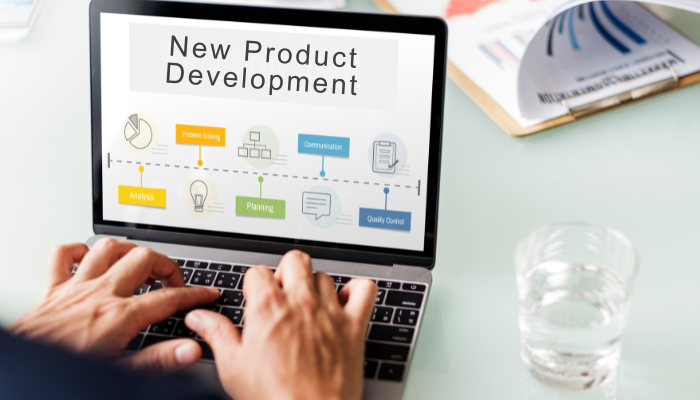“In the digital age, strategy is about more than just technology; it’s about creating value and driving growth through thoughtful planning and execution.”
It stands true for any business looking to thrive in the digital landscape and stand apart from the competition. This is where a digital strategy framework can help by streamlining your processes, improving customer engagement, and boosting overall performance.
But what is a digital strategy framework?
It’s a structured plan that outlines how your organization will use digital tools and technologies to achieve its business goals. It details the steps and resources you will need to move your business forward in the digital world.
At this point, you might want to know how it actually works. To understand that, we must look into its objectives and how it aligns with your business goals.
Objectives of Digital Strategy Framework
While implementing a digital strategy framework, you may set clear objectives such as:
- Improving Customer Experience: Focus on making customer interactions smooth and enjoyable. This means creating user-friendly websites, offering responsive support, and personalizing communications to meet their needs.
- Increasing Operational Efficiency: Streamline your processes to save time and reduce costs. Digital tools can help automate repetitive tasks and improve team collaboration, allowing staff to focus on more impactful work.
- Driving Revenue Growth: Use digital channels to attract new customers and boost sales. Effective online marketing and social media engagement can help convert leads into loyal customers.
- Building Brand Awareness: Establish a strong online presence that resonates with your target audience. Engaging content and consistent messaging across platforms help make your brand memorable.
These goals help you develop a roadmap for your digital initiatives and make sure every effort goes towards your business goals. But why should your digital efforts align with the business goals?
Aligning Digital Initiatives with Business Goals
Your digital strategy should align perfectly with your business goals.
For example, if your business goal is to expand into new markets, your digital strategy framework might include targeted online marketing campaigns and e-commerce solutions to reach potential customers.
To put it simply, your strategy should center around how technology can support your business goals and improve customer experiences.
For instance, a customer relationship management (CRM) system helps you better understand your customers’ needs and preferences. However, the real value in this case comes from using that information to tailor your products/services and strengthen your customer relationship.
Curious about how to make it happen?
- Maximize Impact: Make sure your digital efforts are connected to your business goals. When they align, they become more effective and relevant.
- Cohesive Approach: Create a unified strategy that brings everyone together. This way, you’ll use resources better and avoid wasting time and effort.
- Enhanced Collaboration: Help your teams understand their roles and how they fit into the bigger picture. This fosters teamwork and leads to better results.
- Increased Accountability: When everyone knows how their work supports the business goals, they feel more responsible and motivated to do their best.
- Improved Innovation: With a clear direction, teams can get creative together, leading to fresh ideas and solutions that benefit the whole organization.
Now, let’s look at the steps to develop an effective digital strategy framework that aligns perfectly with your business objectives.
Steps to Develop an Effective Digital Strategy Framework Plan
Before getting into new digital initiatives, you need to take stock of where your business stands today. The first step is to assess the current state of your business processes and technologies.
Step 1: Assessing the Current Business State
Without a proper understanding of where your business lies in terms of current technologies within your digital strategy framework, you may end up wasting time and resources. Here’s a breakdown of how you may assess your current state:
- Evaluate Existing Technologies and Processes
Start by reviewing the tools, software, and platforms you’re currently using. For example:
- Are these solutions meeting your needs, or are they creating inefficiencies?
- Do you have systems that don’t communicate with each other, leading to duplicate data entry?
- Is there outdated software that slows down your operations?
You may also check if manual processes within your digital strategy framework can be automated so they don’t eat up a chunk of your time. Let’s say your team spends hours manually tracking sales leads; you could instead use a customer relationship management (CRM) system to save time and get better insights.
The goal here is to identify what’s working, what’s outdated, and where improvements are needed.
- Perform a Digital Maturity Audit
A digital maturity audit helps you determine how well-prepared your business is to thrive in the digital world. You may assess areas such as operations, customer engagement, and internal collaboration to get an idea of your digital capabilities. For example:
- How integrated are your communication channels with customers?
- Do you offer seamless online experiences, or do customers face hurdles when interacting with your brand?
- On the operations side, you’ll need to evaluate whether automation tools are being used to their full potential.
A digital maturity audit also includes reviewing the data within your digital strategy framework, such as: Are you using analytics effectively to make decisions? Many businesses gather large amounts of data but don’t always act on it.
- Identifying Gaps
After evaluating the technologies and performing a maturity audit within your digital strategy framework, the next step is identifying gaps in your digital capabilities. This includes finding areas where your business is falling behind or where you’re not leveraging technology to its full potential. For example:
- You might find that your competitors are offering personalized experiences through AI-powered chatbots, while your customer service relies solely on email support.
- You may find that your team lacks the necessary skills to manage advanced tools, highlighting the need for training.
Addressing these gaps is essential for building a practical digitization strategy framework. When you know exactly what’s missing, you can create targeted solutions such as upgrading to better tools, automating manual tasks, or upskilling your workforce.
Step 2: Defining Vision and Objectives
Building a successful digital strategy framework starts with one crucial question: What do you want to achieve? Without clear goals and a shared vision, even the most advanced technology won’t bring the results you need.
- Set Strategic Digital Goals
Your digital strategy framework must have measurable, specific goals. It doesn’t mean vague goals such as improving efficiency or boosting sales. Instead, you must focus on achievable targets such as:
- Increasing website traffic by 30% within six months.
- Reducing manual processes by automating 50% of operations.
- Enhancing customer engagement with a 20% rise in online inquiries.
With such strategic digital goals, you can properly guide your team and measure your progress. These goals can be determined through audits of your technologies and processes.
- Collaboration with Stakeholders
True digital transformation requires teamwork between multiple departments. Each team plays a role in bringing your digital strategy framework to life with unique insights. For example:
- Your marketing team might highlight the need for tools that enhance personalization.
- Your operations team could suggest automating supply chain processes.
- IT can check the feasibility of these ideas and make sure they’re smoothly integrated with your current systems.
You can ensure everyone shares ownership of the strategy and helps prevent bottlenecks later.
- Align Digital Strategy with Broader Business Strategy
For your digital strategy framework to work, it must fit naturally within the larger business strategy. That means your digital efforts should directly support your company’s mission and long-term goals. For instance:
- If your business goal is to expand into new markets, your digital strategy might focus on creating an e-commerce platform and optimizing mobile experiences.
- If customer retention is your top priority, then developing personalized digital touchpoints becomes essential.
This blog on the Product Management Process discusses how businesses can adapt their product development strategies in a digital environment. Read it to understand the need for a robust approach to incorporating digital technologies in product development.
This way you can ensure that every digital initiative from a new CRM system to an automation platform adds real value to the business.
Step 3: Prioritizing and Planning Digital Initiatives
When building a digital strategy framework, it’s easy to get excited about the many possibilities. However, not every idea will align with your business goals or provide meaningful results. The key to success lies in selecting the right initiatives and organizing them into a structured action plan.
- Review Strategic Options and Select Priority Initiatives
The first step in planning your digitization strategy framework is to list all possible digital initiatives. These might include:
- Adopting automation tools
- Improving customer experiences through better UI/UX design
- Implementing advanced analytics to guide business decisions
However, not every initiative will have the same value. It’s important to assess which ones align best with your strategic goals. Here’s how you can approach this:
- Does the initiative support your growth, improve operational efficiency, or enhance customer satisfaction?
- Does your team have the capacity to manage the initiative, or will it require hiring additional expertise?
- Are your competitors already adopting this technology? If yes, will it give you an edge or help you meet customer expectations?
Want to elevate your customer interactions? Codewave’s Customer Experience Design service is here to create seamless and engaging experiences that keep your clients coming back for more!
- Balance Impact and Feasibility of Initiatives
Some initiatives sound great on paper but might not be practical given your current resources, budget, or timelines within your digital strategy framework. You must assess the impact vs. feasibility of each option.
You can break each option down into these categories:
- High-Impact, High-Feasibility: These are your priority initiatives. They bring tangible results and are achievable with the resources you have. For example, automating invoicing processes might improve cash flow while requiring low implementation effort.
- High-Impact, Low-Feasibility: These initiatives may promise substantial benefits but come with higher risks, costs, or time requirements. For instance, building a fully customized CRM system might boost long-term customer relationships but require substantial investment and development time. These initiatives should be tackled only when resources are available.
- Low-Impact, High-Feasibility: While these projects may be easy to implement, they don’t contribute much to your overall goals. It’s best to deprioritize them and focus on initiatives that better align with your strategy.
Ready to take your digital initiatives to the next level? At Codewave, we specialize in aligning your goals with the right strategies. Learn how our design thinking approach helps you prioritize projects that matter with a focus on user-centric solutions that deliver real value.
- Develop a Detailed Action Plan
After identifying and prioritizing your initiatives within your digital strategy framework, it’s time to organize them into a clear action plan. An action plan helps you stay on track by defining what needs to be done, when, and by whom. Here’s how you can structure your plan:
- Break Initiatives into Milestones: Large initiatives, like building a mobile app, should be divided into smaller tasks (e.g., prototyping, testing, launching).
- Set Clear Timelines: Assign realistic deadlines to each milestone. A detailed timeline gives your team a sense of urgency without overwhelming them with tasks.
- Assign Ownership and Accountability: Assign every task to specific individuals or departments. For example, your marketing team might oversee content management tools, while your IT team handles infrastructure upgrades.
With a structured plan, you can not only execute each digital initiative smoothly but also identify potential bottlenecks early on.
Step 4: Investing in Technologies and Building Teams
In any effective digital strategy framework, technology and people go hand in hand. A well-thought-out plan is about making strategic investments in technology and building adaptive teams to bring your digital vision to life.
- Strategic Alignment of Technology Investments
Every tech investment must support your broader business goals. Here’s how you can make strategic technology investments:
- Evaluate ROI in Business Terms: Focus on how technology can boost productivity, reduce costs, or improve customer experience. For example, you can automate your back-office operations to cut manual labor hours and reduce human errors.
- Plan for Scalability: Choose technologies that can grow with your business. For example, a cloud-based CRM can support a growing customer base without any major upgrades.
- Integrate Systems Across Teams: Your tech investments should offer seamless collaboration across departments. For instance, you can integrate marketing tools with sales software to streamline lead management.
By following these, you can ensure that every dollar you spend contributes to tangible business outcomes.
- Suitable Tech Adoption
It’s important to choose tools that enhance creativity and operations across teams within your digital strategy framework. Here’s how to get the most out of your chosen technology:
- Experiment with Emerging Technologies: Innovation requires some experimentation. For example, many companies are exploring low-code platforms to quickly build apps and solutions without waiting on extensive IT development cycles.
- Encourage Cross-Functional Collaboration: Use tools such as Slack or Microsoft Teams that make communication easier and encourage knowledge sharing.
- Focus on Automation Where It Counts: Automating routine tasks can free up your employees to focus on creative problem-solving and higher-level work. For example, chatbots can handle repetitive customer service inquiries, allowing your team to focus on more complex requests.
Looking to take your tech game to the next level? With Codewave’s embedded technology innovation, you can seamlessly integrate the right tools for your team. Let us help you enhance creativity and streamline operations, so you can focus on what truly matters!
- Build Agile and Adaptive Teams
Even the best technologies won’t yield results without the right people behind them. You must try building agile teams—teams that can quickly respond to changes and challenges. Here’s how:
- Encourage continuous learning through workshops, certifications, or cross-training between departments to keep your teams up to date with the latest trends and tools.
- Look for people who are comfortable with change and can learn new technologies quickly.
- Agile teams work best when they have the freedom to make decisions. Empower your teams to experiment with new ideas, fail fast, and learn from their experiences.
The best tech is only as good as the people using it. That’s why building agile, adaptable teams is key.
Codewave‘s GenAI development services can help you take your team to the next level. Our team of experts can help you develop custom AI solutions that automate tasks, streamline workflows, and free up your team to focus on what they do best – crushing innovation goals!
Step 5: Monitoring, Evaluation, and Iteration
An effective digital strategy framework isn’t something you set and forget. It’s a dynamic plan that needs constant monitoring, evaluation, and fine-tuning to stay relevant.
- Establish Key Performance Indicators (KPIs)
KPIs give you clear targets to work toward so you can assess whether your digital efforts are aligned with your business goals. Here’s how you can set effective KPIs:
- Tie KPIs to Business Objectives: For example, if your goal is to increase revenue, track metrics like conversion rates and average order value.
- Set Measurable Targets: KPIs should be specific and quantifiable, such as aiming for a 10% increase in sales or a 5-day reduction in project delivery time.
- Use Leading and Lagging Indicators: Combine metrics that show real-time performance (like daily active users) with outcomes that reflect long-term success (like customer retention rates).
Having relevant KPIs in place helps you check whether your strategy is delivering results or if adjustments are required.
- Continuous Monitoring and Evaluation of Strategy
Once your digital initiatives are live, regular monitoring within your digital strategy framework can help ensure you stay on course. It’s not enough to simply collect data—you need to evaluate it to understand how your efforts are performing. Here’s how:
- Leverage Real-Time Dashboards: Tools like Google Analytics, Power BI, or custom dashboards allow you to monitor performance metrics in real time and get instant feedback.
- Conduct Periodic Reviews: Schedule monthly or quarterly reviews with stakeholders to evaluate the progress of key initiatives. You can identify trends early and act before they turn into major issues.
- Identify Bottlenecks and Opportunities: Monitoring helps you detect areas where things are slowing down or where your strategy could benefit from further investment or optimization. For example, a drop in website traffic might signal the need for better SEO efforts.
Don’t just collect data – use it to understand what’s working and what’s not. Codewave‘s data strategy, analytics, and predictive intelligence services can be your secret weapon! Our team of data wizards can help you make sense of all your data, identify opportunities for improvement, and ensure your innovation strategy continues to soar.
- Iterative Improvement and Adjustment
No strategy is perfect from the start. The key to long-term success in your digital strategy framework lies in iteration—making incremental improvements based on what you learn along the way. An iterative approach lets you stay ahead of market changes and evolving customer expectations.
Here’s how you can effectively implement iterative improvements:
- Act on Data-Driven Insights: Use the insights from your monitoring efforts to tweak your strategy. For example, if customers are dropping off during checkout, you might redesign the checkout process for simplicity.
- Experiment with Small Changes: Test new ideas using A/B testing or pilot programs before rolling them out fully. This way you can learn what works without risking the entire strategy.
- Maintain Flexibility in Planning: Digital strategies need room for adjustments. Rather than rigid timelines, focus on goals and make course corrections as needed. With a flexible plan, you can adapt to emerging trends and market shifts.
Iteration helps you find new opportunities to optimize and evolve your digital strategy over time.
How Codewave Can Transform Your Digital Strategy Framework
At Codewave, we’re all about Design Thinking Led and Digital Innovation. We specialize in creating solutions that not only meet your needs but also delight your customers. Our team combines creativity with technology to help businesses thrive in today’s digital world.
When it comes to digital transformation, here’s why Codewave should be your go-to partner:
- CX Delight: We craft high-stakes ‘customer-touchpoint’ tech with precision engineering, ensuring every interaction is smooth and engaging.
- Omnichannel: Our integrated experiences across channels make it easy for customers to connect with your brand wherever they are.
- Agility: We design your digital business for maximum adaptability and resilience, so you can pivot quickly when needed.
- Data: We collect necessary live data for analysis and predictions, giving you the insights you need to make informed decisions.
- Intelligence: Our tools provide actionable insights, turning data into a powerful asset.
- 3S of Tech: Our tech development ensures speed, security, and scale to keep your operations running smoothly.
- Serverless: We optimize your cloud infrastructure costs as you grow.
- Releases: Expect rapid, secure releases without the drama.
Ready to enhance your digital strategy framework? Let’s talk!
Conclusion
A well-thought-out digital strategy framework is essential for long-term business success. It ensures that every digital initiative, whether it’s customer engagement, operational efficiency, or new product development, aligns with your overall business goals.
However, the digital world is in a state of constant change. A structured framework gives you the foundation to operate efficiently while also being flexible enough to adapt to emerging trends.
You can create a thriving digital presence that scales with your business through a solid digital strategy framework, adaptable tools, and strong leadership.
If you’re ready to take your digital transformation to the next level, Codewave can guide you through the process. At Codewave, we provide the expertise and tools to make your vision a reality whether it’s building a new product, scaling your technology, or refining existing processes.
Ready to unleash your business’s potential with a future-ready strategy? Let Codewave guide you through every step—design, development, and beyond.Also read Examples of Successful Digital Transformation in Companies.
Codewave is a UX first design thinking & digital transformation services company, designing & engineering innovative mobile apps, cloud, & edge solutions.







